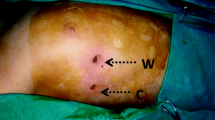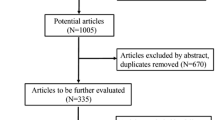Abstract
Background
Despite good short-term results and patient satisfaction with endoscopic thoracic sympathectomy (ETS), there has been much debate on the level of sympathectomy for treatment of palmar hyperhidrosis (PH) in terms of long-term clinical outcomes.
Objective
The aim of the study was to analyze the long-term recurrence and compensatory hyperhidrosis (CH) rates of ETS, comparing single-level T2 against multi-level T2–T3 ablation in single patients.
Methods
Patients who had undergone treatment for PH with unilateral T2 and contralateral T2–T3 ablation in ETS were retrospectively reviewed. They were subjected to telephone interview using standardized set of interview script and questionnaire with a scoring system similar to hyperhidrosis disease severity scale. All patients were evaluated for comparison of symptom resolution, site and severity of CH, and satisfaction rates. To compare between T2 and T2–T3, the level of sympathectomy on one side is matched to the ipsilateral recurrence of PH and CH occurrence.
Results
Twenty-two patients with a mean age of 36.5 years could be reached. The mean follow-up was 8 years (range 38–153 months). The global recurrence rate for PH is 18 %. CH was observed in 20 (91 %) patients, and trunk compensation was the most common (18/22–82 %), followed by lower limb (14/22–64 %) and axilla (10/22–45 %). Overall, 72.8 % (16) of the patients were satisfied with the operation. Among the six patients who were not satisfied, two patients reported recurrence of symptoms, while four patients experienced some form of compensation. There was no absolute difference in the severity of sweating bilaterally for patients who reported recurrence of PH. The site and severity of CH were also bilaterally symmetrical for all patients.
Conclusion
There was no difference in recurrence rates and CH between single-level (T2) and multi-level (T2–T3) ETSs in the long term.

Similar content being viewed by others
References
Dumont P, Denoyer A, Robin P (2004) Long-term results of thoracoscopic sympathectomy for hyperhidrosis. Ann Thor Surg 78:1801–1807
Kwong KF, Hobbs JL, Cooper LB, Burrows W, Gamliel Z, Krasna MJ (2008) Stratified analysis of clinical outcomes in thoracoscopic sympathicotomy for hyperhidrosis. Ann Thorac Surg 85:390–393 (discussion 393–394)
Zacherl J, Huber ER, Imhof M, Plas EG, Herbst F, Fugger R (1998) Long-term results of 630 thoracoscopic sympathicotomies for primary hyperhidrosis: the Vienna experience. Eur J Surg 580:43–46
Ojimba TA, Cameron AE (2004) Drawbacks of endoscopic thoracic sympathectomy. Br J Surg 91:264–269
Rex LO, Drott C, Claes G, Gothberg G, Dalman P (1998) The Boras experience of endoscopic thoracic sympathicotomy for palmar, axillary, facial hyperhidrosis and facial blushing. Eur J Surg 580:23–26
Li X, Tu YR, Lin M, Lai FC, Chen JF, Dai ZJ (2008) Endoscopic thoracic sympathectomy for palmar hyperhidrosis: a randomized control trial comparing T3 and T2-4 ablation. Ann Thor Surg 85:1747–1751
Cerfolio RJ, De Campos JR, Bryant AS, Connery CP, Miller DL, DeCamp MM, McKenna RJ, Krasna MJ (2011) The Society of Thoracic Surgeons expert consensus for the surgical treatment of hyperhidrosis. Ann Thor Surg 91:1642–1648
Lai CL, Chen WJ, Liu YB, Lee YT (2001) Bradycardia and permanent pacing after bilateral thoracoscopic T2-sympathectomy for primary hyperhidrosis. Pacing Clin Electrophysiol PACE 24:524–525
Munia MA, Wolosker N, Kauffman P, de Campos JR, Puech-Leao P (2007) A randomized trial of T3-T4 versus T4 sympathectomy for isolated axillary hyperhidrosis. J Vasc Surg 45:130–133
Yang J, Tan JJ, Ye GL, Gu WQ, Wang J, Liu YG (2007) T3/T4 thoracic sympathictomy and compensatory sweating in treatment of palmar hyperhidrosis. Chin Med J 120:1574–1577
Gossot D, Galetta D, Pascal A, Debrosse D, Caliandro R, Girard P, Stern JB, Grunenwald D (2003) Long-term results of endoscopic thoracic sympathectomy for upper limb hyperhidrosis. Ann Thor Surg 75:1075–1079
Herbst F, Plas EG, Fugger R, Fritsch A (1994) Endoscopic thoracic sympathectomy for primary hyperhidrosis of the upper limbs. A critical analysis and long-term results of 480 operations. Ann Surg 220:86–90
Katara AN, Domino JP, Cheah WK, So JB, Ning C, Lomanto D (2007) Comparing T2 and T2–T3 ablation in thoracoscopic sympathectomy for palmar hyperhidrosis: a randomized control trial. Surg Endosc 21:1768–1771
Solish N, Bertucci V, Dansereau A, Hong HC-H, Lynde C, Lupin M, Smith KC, Storwick G (2007) A Comprehensive Approach to the Recognition, Diagnosis, and Severity-Based Treatment of Focal Hyperhidrosis: recommendations of the Canadian Hyperhidrosis Advisory Committee. Dermatol Surg 33:908–923
Schmidt J, Bechara FG, Altmeyer P, Zirngibl H (2006) Endoscopic thoracic sympathectomy for severe hyperhidrosis: impact of restrictive denervation on compensatory sweating. Ann Thor Surg 81:1048–1055
Yazbek G, Wolosker N, de Campos JR, Kauffman P, Ishy A, Puech-Leao P (2005) Palmar hyperhidrosis–which is the best level of denervation using video-assisted thoracoscopic sympathectomy: T2 or T3 ganglion? J Vasc Surg 42:281–285
Hsu CP, Chen CY, Hsia JY, Shai SE (1998) Resympathectomy for palmar and axillary hyperhidrosis. Br J Surg 85:1504–1505
Lin TS (2001) Video-assisted thoracoscopic “resympathicotomy” for palmar hyperhidrosis: analysis of 42 cases. Ann Thor Surg 72:895–898
Lyra Rde M, Campos JR, Kang DW, Loureiro Mde P, Furian MB, Costa MG, Coelho Mde S, Brasileira Sociedade, de Cirurgia T (2008) Guidelines for the prevention, diagnosis and treatment of compensatory hyperhidrosis. Jornal brasileiro de pneumologia: publicacao oficial da Sociedade Brasileira de Pneumologia e Tisilogia 34:967–977
Sugimura H, Spratt EH, Compeau CG, Kattail D, Shargall Y (2009) Thoracoscopic sympathetic clipping for hyperhidrosis: long-term results and reversibility. J Thorac Cardiovasc Surg 137:1370–1376 (discussion 1376–1377)
Chiou TS, Chen SC (1999) Intermediate-term results of endoscopic transaxillary T2 sympathectomy for primary palmar hyperhidrosis. Br J Surg 86:45–47
Lai YT, Yang LH, Chio CC, Chen HH (1997) Complications in patients with palmar hyperhidrosis treated with transthoracic endoscopic sympathectomy. Neurosurgery 41:110–113 (discussion 113-115)
Al Dohayan A (1999) Transaxillary thoracoscopic sympathectomy experience in a hot climate: management of the dominant hand. Surgical laparoscopy, endoscopy & percutaneous techniques 9:317–321
Chou SH, Kao EL, Lin CC, Chang YT, Huang MF (2006) The importance of classification in sympathetic surgery and a proposed mechanism for compensatory hyperhidrosis: experience with 464 cases. Surg Endosc 20:1749–1753
Panhofer P, Zacherl J, Jakesz R, Bischof G, Neumayer C (2006) Improved quality of life after sympathetic block for upper limb hyperhidrosis. Br J Surg 93:582–586
Kopelman D, Hashmonai M (2008) The Correlation Between the Method of Sympathetic Ablation for Palmar Hyperhidrosis and the Occurrence of Compensatory Hyperhidrosis: a Review. World J Surg 32:2343–2356
Milanez de Campos JR, Kauffman P, de Campos Werebe E, Andrade Filho LO, Kusniek S, Wolosker N, Biscegli Jatene F (2003) Quality of life, before and after thoracic sympathectomy: report on 378 operated patients. Ann Thor Surg 76:886–891
Liu Y, Yang J, Liu J, Yang F, Jiang G, Li J, Huang Y, Wang J (2009) Surgical treatment of primary palmar hyperhidrosis: a prospective randomized study comparing T3 and T4 sympathicotomy. Eur J Cardio Thorac Surg 35:398–402
Byrne J, Walsh TN, Hederman WP (1990) Endoscopic transthoracic electrocautery of the sympathetic chain for palmar and axillary hyperhidrosis. Br J Surg 77:1046–1049
Drott C, Gothberg G, Claes G (1995) Endoscopic transthoracic sympathectomy: an efficient and safe method for the treatment of hyperhidrosis. J Am Acad Dermatol 33:78–81
Hashmonai M, Kopelman D, Kein O, Schein M (1992) Upper thoracic sympathectomy for primary palmar hyperhidrosis: long-term follow-up. Br J Surg 79:268–271
Kopelman D, Hashmonai M, Ehrenreich M, Assalia A (1998) Thoracoscopic sympathectomy for hyperhidrosis: is there a learning curve? Surg Laparosc Endosc 8:370–375
Chiou TS (2005) Chronological changes of postsympathectomy compensatory hyperhidrosis and recurrent sweating in patients with palmar hyperhidrosis. J Neurosurg Spine 2:151–154
Author information
Authors and Affiliations
Corresponding author
Ethics declarations
Disclosures
Drs. Wilson Ong, Alvin Lee, Tan Wee Boon, and Davide Lomanto have no conflicts of interest or financial ties to disclose.
Rights and permissions
About this article
Cite this article
Ong, W., Lee, A., Tan, W.B. et al. Long-term results of a randomized controlled trial of T2 versus T2–T3 ablation in endoscopic thoracic sympathectomy for palmar hyperhidrosis. Surg Endosc 30, 1219–1225 (2016). https://doi.org/10.1007/s00464-015-4335-2
Received:
Accepted:
Published:
Issue Date:
DOI: https://doi.org/10.1007/s00464-015-4335-2




